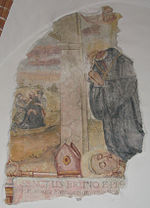Bruno of Querfurt
Saint Bruno of Querfurt | |
|---|---|
 A medieval fresco depicting St. Bruno's death | |
| Apostle of the Prussians | |
| Born | 970 Querfurt |
| Died | February 14, 1009 |
| Venerated in | Roman Catholicism |
| Feast | October 15 |
Saint Bruno of Querfurt (c. 970 – February 14 1009) (also known[citation needed] as Brun and Boniface) is a saint and martyr, who was killed while trying to spread Christianity in Eastern Europe. He is sometimes called the second Apostle of the Old Prussians.
Biography
Early life
Bruno was from a noble family of Querfurt, Saxony. He is rumored to have been a relative of the Holy Roman Emperor Otto III. At the age of six he was sent to be educated in Magdeburg, seat of Adalbert of Magdeburg, the teacher and namesake of Saint Adalbert. While still a youth he was made a canon of Magdeburg cathedral. The fifteen-year-old Otto III made Bruno a part of his royal court. While in Rome for Otto's imperial coronation, Bruno met Adalbert of Prague, the first Apostle of the Prussians, killed a year later, which inspired Bruno to write a biography of Adalbert. Bruno spent much time at the monastery where Adalbert had become a monk and where also abbot John Canaparius wrote a life of Saint Adalbert. Bruno entered a monastery near Ravenna, founded by Otto, and underwent severe ascetic training under the guidance of St. Romuald.
Missionary life
Otto III hoped to open a monastery between the Elbe and the Oder to help convert the local population into Christianity. In 1003 Pope Sylvester II appointed Bruno to mission among the pagan peoples of Eastern Europe. Because of a conflict between the Henry II, Holy Roman Emperor and Boleslaus I of Poland delayed the plans for the monastery, Bruno set out for Hungary. There he went to the places that Saint Adalbert of Prague had attended. Bruno tried to convert Ahtum, Duke of Banat, who was an Orthodox. Bruno encountered strong opposition, including that of the Greek monks there. After this failure, Bruno went to Kiev, where Grand Duke Vladimir I authorized him to make converts among the Pechenegs, semi-nomadic Turkic peoples living between the Danube and the Don rivers. Bruno spent five months there and baptized some thirty adults. He helped to bring about a peace treaty between them and the ruler of Kiev.
Before leaving for Poland, Bruno consecrated a bishop for the Pechenegs. While in Poland he consecrated the first Bishop of Sweden. Bruno found out that his friend Benedict and four companions had been killed by robbers in 1003. Bruno took eyewitness accounts and wrote down a touching history of the so-called Five Martyred Brothers.
Mission in Prussia and death
At the end of 1008 Bruno and eighteen companions set out to found a mission among the Prussians, but met with little success. They then traveled to the north-east, heading towards Lithuania. Along the border of Kievan Rus and Lithuania, Bruno succeeded in converting Netimeras, a local ruler of Yotvingians. However, not all were happy with the changes and, according to Wipert, the only surviving member of the expedition, Bruno and 18 of his his companions were beheaded on February 14, 1009. Duke Boleslaus brought the bodies to Poland; it is said that Braunsberg was named after Bruno. They were laid probably in Przemyśl south-east of Poland where historians place Bruno's diocese. Soon after his death Bruno and his companions were revered as martyrs and Saint Bruno was canonized. Annals of the monastery of Quedlinburg recorded the story; it was the first time the name of Lithuania was mentioned in written sources.
